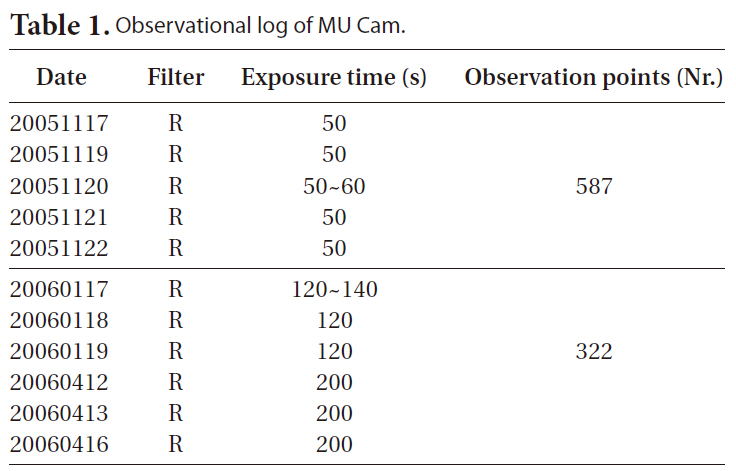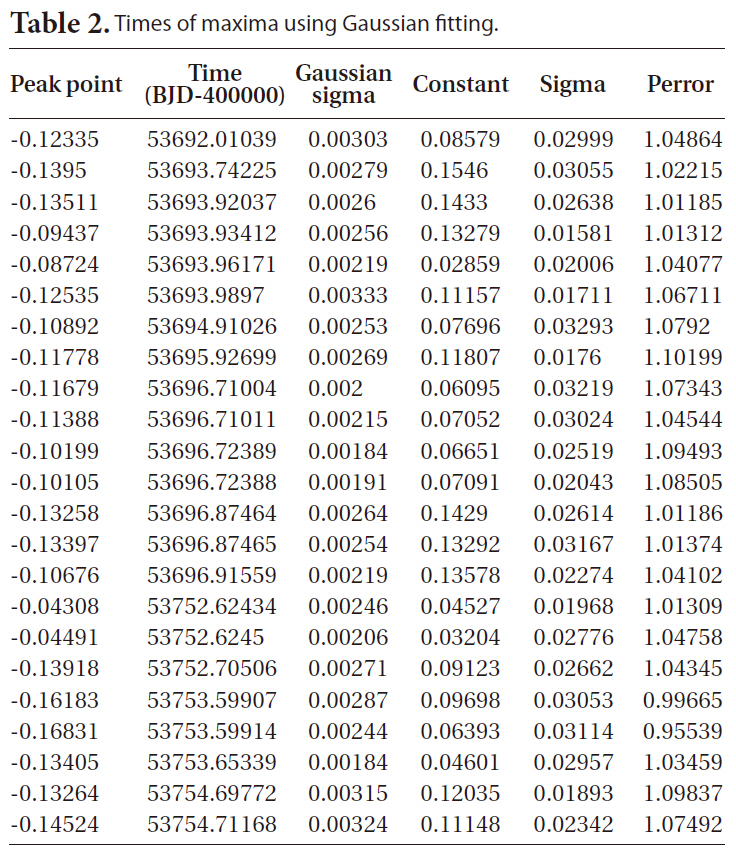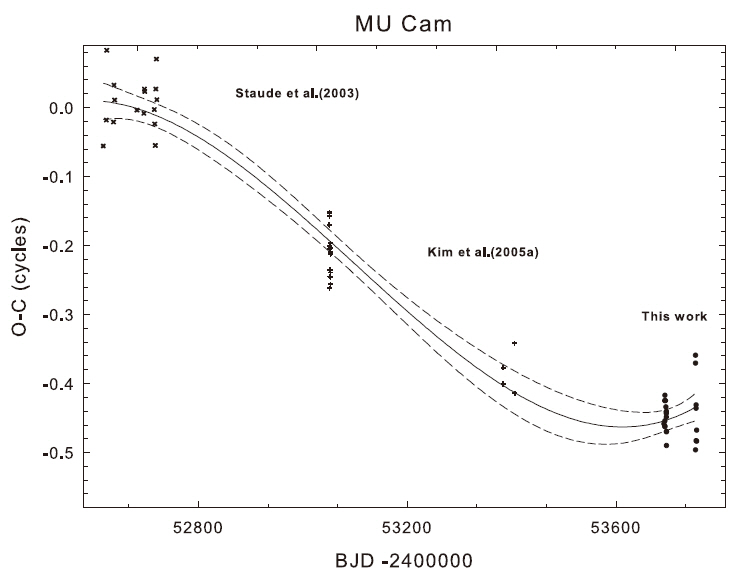



MU Camelopardalis (MU Cam) was first observed by the ROSAT All-Sky Survey (RASS) as an X-ray source, 1RXS J062518.2+733433, and later it has identified as an optical counterpart of this X-ray source by Kazarovets et al.(2006). Wei et al. (1999) classified this object as a cataclysmic variable with the spin period of 0.d01374127(5) and the orbital period of 0.d19661(27). Even though no definite characteristics about the eclipse have been reported yet, the optical pulse profile represents a sinusoidal single peak. Staude et al. (2003) reported a relativly strong HeII emission line which shows the existence of photons able to ionize the atoms. This characteristic has been discussed by other authors (Araujo-Betancor et al. 2003,Staude et al. 2003, 2008, Kim et al. 2005a, Kozhevnikov et al. 2006). These observational characteristics led to the classification of this object as an intermediate polar or DQ Her type magnetic cataclysmic variable.
The spin period of intermediate polars generally vary in the course of time (Warner 1986, 1995, Patterson 1994,Hellier 2001). Many corrections of the MU Cam spin period have been reported by several authors (Araujo-Betancor et al. 2003, Staude et al. 2003, Kim et al. 2005a). In order to study the rotational evolution of magnetic white dwarfs in intermediate polars, a long time-base monitoring of the spin period variation is definitely needed.This object has been included in the list of key targets of the inter-longitude astronomy (ILA) project (Andronov et al. 2003). As results of this project, deceleration and acceleration of the spin in the intermediate polars have already been detected: deceleration in BG CMi by Kim et al. (2005b) and alternatively, acceleration in FO Aqr (Andronov et al. 2005).
In this paper, we present results based on 11 nights of R charge-coupled device (CCD)-photometry obtained in 2005-2006 with a 1 m telescope of the Korean Astronomy Observatory at Mt. Lemmon in the USA.
MU Cam was observed with a 2 K by 2 K CCD camera mounted on the 1 m telescope at Mt. Lemmon Optical Astronomy Observatory during the 2005 and 2006 season. Given the CCD plate scale of 0.64 arcsec/pixel at f/7.5 Cassegrain focus, the image field of view was 22.2 arcmin by 22.2 arcmin. We obtained R-filter CCD photometry data from 11 nights from November 2005 to April 2006. The observational log is presented in Table 1 with exposure time and total observation points. A total of 907 points of observation were used for this study.
To determine the instrumental magnitudes of stars in the field of MU Cam, the IRAF/DAOPHOT package (Massey & Davis 1992) has been used. For the final determination of magnitudes, the computer program multi-column view by Andronov & Baklanov (2004) has been used, which uses the method of multiple comparison stars (Kim et al. 2004).
In the method of multiple comparison stars, an independent R brightness estimate of 7 bright stars in the vicinity of the MU Cam was made based on the method described in Kim et al. (2005a). The standardized R light curve has been obtained by using an artificial star which made it possible to increase accuracy estimates. The R magnitude of MU Cam varied from 15.5 mag to 14.7 mag in the 2005-2006 season as shown in Fig. 1. A bright state and a faint state are not shown in this season, which is clearly seen by Kim et al. (2005a).
The spin period of MU Cam has been found from the
power spectrum analysis (Lenz et al. 2005) using the usual Fourier transformation as following:
Here Z is a zero point of f(t), Ai, Ωi Φi are the amplitude at the frequency
[Table 1.] Observational log of MU Cam.

Observational log of MU Cam.
[Table 2.] Times of maxima using Gaussian fitting.

Times of maxima using Gaussian fitting.
MU Cam is a faint object (R magnitude~15.5-14.7 in the 2005-2006 season) and has a relatively short spin period, which leads to very small points of observation near the extremes. The exact estimation of times of extreme needs a very complicated numerical analysis. Such analysis will be presented separately elsewhere. In this paper, we want to check the general behaviour of the spin period in the time series. For this purpose a simple Gausian fitting has been adapted. The fitting equation is
where A(0), A(1) and A(2) are the peak value, the position at peak center and the Gausian width respectively. A total of 56 times of extremes have been found in our data, and 23 maximum timing data are used for the O-C analysis. These times of maxima obtained by Gaussian fitting are listed in Table 2.
The found spin period of MU Cam, 0.d01373801(59), seems to be the same value as Staude et al. (2003) and Kim et al. (2005a) in the error interval. But it is necessary to check for the possible period variations,
Staude et al. (2003) presented a precise ephemeris,
using a compilation of their own maxima timings and maxima timings obtained from the photometric data of Arajo-Betancor et al. (2003). With this basic ephemeris, Kim et al. (2005a) tried to fit a cubic parabola to the O-C diagram with their timing in the season of 2004-2005 as well as the data of Staude et al. (2003), because the parabolic fit did not deviate significantly from the line. They found statistically significant variation in an ephemeris:
Adding our maxima timings of 2005-2006 to this O-C diagram and fitting to a cubic parabola leads to an ephemeris
which exhibits a possible trend to spin up. The fitting result is shown in Fig. 2. Even if we see a clear variation of the spin period of MU Cam, it is unclear whether the spin period will become slower or faster in the future. Staude et al. (2008) suggested that MU Cam has different accretion states which causes to the significant change in brightness and also the change of the spin period. In order to study this problem in more detail, we need further monitoring of this interesting intermediate polar.
Recently, a deceleration of the spin period (
Even if a more complicated treatment is needed for understanding the angular momentum from the disk in the magnetic compact star, we can estimate the torque of MU Cam by using a simple consideration in order to
show how important monitoring the period variation is.
The torque (τ) is a variation of the angular momentum (L) per unit of time. By using
where I is the moment of inertia (and ω is the angular velocity given by the spin period (P) of the star (ω=2π/P). With results of this paper (



